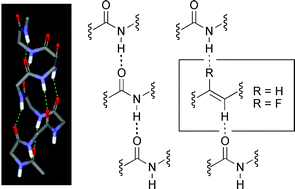Peptide bond mimicry by (E)-alkene and (Z)-fluoroalkene peptide isosteres: synthesis and bioevaluation of α-helical anti-HIV peptide analogues†
Abstract
The α-helix structures of the anti-HIV fusion inhibitory

* Corresponding authors
a
Graduate School of Pharmaceutical Sciences, Kyoto University, Sakyo-ku, Kyoto, Japan
E-mail:
soishi@pharm.kyoto-u.ac.jp, nfujii@pharm.kyoto-u.ac.jp
Fax: +81-75-753-4570
Tel: +81-75-753-4551
b Laboratory of Virus Control, Institute for Virus Research, Kyoto University, Sakyo-ku, Kyoto, Japan
The α-helix structures of the anti-HIV fusion inhibitory

 Please wait while we load your content...
Something went wrong. Try again?
Please wait while we load your content...
Something went wrong. Try again?
S. Oishi, H. Kamitani, Y. Kodera, K. Watanabe, K. Kobayashi, T. Narumi, K. Tomita, H. Ohno, T. Naito, E. Kodama, M. Matsuoka and N. Fujii, Org. Biomol. Chem., 2009, 7, 2872 DOI: 10.1039/B907983A
To request permission to reproduce material from this article, please go to the Copyright Clearance Center request page.
If you are an author contributing to an RSC publication, you do not need to request permission provided correct acknowledgement is given.
If you are the author of this article, you do not need to request permission to reproduce figures and diagrams provided correct acknowledgement is given. If you want to reproduce the whole article in a third-party publication (excluding your thesis/dissertation for which permission is not required) please go to the Copyright Clearance Center request page.
Read more about how to correctly acknowledge RSC content.
 Fetching data from CrossRef.
Fetching data from CrossRef.
This may take some time to load.
Loading related content
